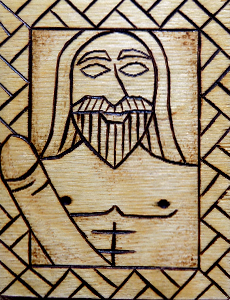 Freyr Basics
Freyr Basics
Freyr is one of the most important gods of the Norse mythology. He is widely considered equal to Óðin and Thor, the latter with whom he shares many overlapping domains.
This makes sense when you consider the reach of the ancient Norse, and the varying regional belief systems that were later consolidated to create a single (more or less) mythology. “Freyr” – meaning “Lord” – is more a title than a name.
We find the name Yngvi associated with Freyr in an Anglo-Saxon rune poem. There are several other connections made, including a mention by Tacitus in Germania, a passage in Beowulf, and in ancestral documents of the Swedish Royal Family (the Ynglings) who are in legend descended from the god Yngvi-Freyr. Claiming descent from divinity was common throughout various pagan cultures, and certainly in the development of Christianity, who’s monarchs even today claim a divine right to kingship.
Freyr is attested to in the Poetic Edda, Prose Edda, Tacitus’s late first century work Germania, in Adam of Bremen’s Gesta Hammaburgensis Ecclesiae Pontificum in the 11th century, in Skaldic poetry, in the 12th Century Danish Gesta Danorum, in the 14th century Icelandic Ögmundar þáttr dytts, and in the Icelandic sagas.
Many archaeological artifacts have been found depicting Freyr, and there are numerous place-names honouring him spanning throughout Norway, the Netherlands, and Sweden, further attesting to his widespread importance.
Freyr is described as remarkably handsome and is considered alongside his sister, Freya a deity of love, sexuality and fertility. He is one of the Vanir, traded to the Æsir along with his sister and father, Njörðr in the exchange of hostages that cemented peace between the two warring tribes of gods.
Freyr is associated with agriculture, and with enjoying the fruits of the harvest. He is the god of labour and the enjoyment that follows. Snorri Sturlson describes Freyr in his Prose Edda:
“Freyr is the most renowned of the Æsir; he rules over the rain and the shining of the sun, and therewithal the fruit of the earth; and it is good to call on him for fruitful seasons and peace. He governs also the prosperity of men.”
He owns two of the six magical treasures of the gods, made by Dwarf master smiths. The first is Gullinbursti, a sun-like golden boar that serves as his mount, and which can run through the sky and over land. The second is Skíðblaðnir, a ship made of gold that could sail without wind and which folded up to fit in his pocket.
Freyr also possessed a magical sword which wielded itself. He gave it to his manservant Skirnir, to hold onto in exchange for braving the harrowing trip to Jötunheimr to propose to Freyr’s future wife, Gerð. Even without his sword, Freyr is a fierce warrior who famously slew the giant Beli with just an antler!
Freyr is the penetrating sun, the god of Summer, while Gerð is the frozen earth goddess of Winter. The aggressiveness in the tale as recounted in the Eddas is thought to be a metaphor for the thawing of the Winter frosts and the slow warming of the earth.
At Ragnarök, Freyr is left to fight the fire-giant Surtr without his wondrous sword, and according to Snorri he does not survive. Freyr is considered both a god of war and peace. His sacred animal the boar was popularly invoked among Germanic and Nordic tribal warriors.
Freyr is the ruler of Álfheimr, one of the Nine Worlds, the realm of the Alfar. The Alfar eventually became the elves and fairies of later legend, but before that, they were human ancestors – the exalted dead of the pagan peoples. Along with the spirits of the land, they were given tribute and veneration. Many scholars consider the ancestors to have been more important than the gods to the daily lives of the ancients.
There are many connections to be made between burial mounds throughout Europe, the elves, ancestor worship, and Freyr. He was worshiped at a huge temple-mound complex at Uppsala in Sweden, and was venerated with pilgrimages made to this site, as well as processions throughout the lands in which he was worshiped. He is recorded to have been worshiped by men who danced wearing bells. This is reminiscent of modern Morris dancers – who dance with bells, and poke the earth with staves as part of an old courtship ritual to wake up the frozen earth goddess.
ydalir.ca
Suggested Signs & Symbols
Boars, pigs, farms, fields, harvest crops. Sickles, scythes, and harvest symbols. Summer. Seeds and pollen. Kings. Swords, antlers, and phallic symbols. Stags, bulls and stallions. Food (especially unprocessed), feasts, festivals, and bawdy humour. Friday. The colours green, brown and gold. Freyfaxi (August 21) and Lammas (August 1-2.). Bells, percussion instruments, Morris dancers. The rune Yngvi.
ydalir.ca
Associated Names
Frey, Yngvi, Yngvi-Freyr, Ingui, Ing, Frawjaz, Fricco, Frø, Freo, Ingawz.
